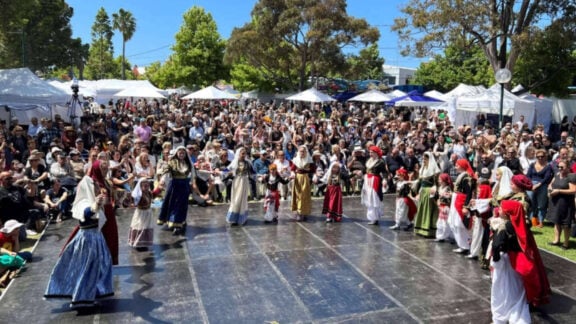In contemporary multicultural democracies, the naming of public space constitutes a potent semiotic act, one that not only honours individuals or events but also inscribes hegemonic narratives into the very spatial and mnemonic fabric of the city. Far from being neutral, the selection of whose names are affixed to streets, laneways, and public infrastructure is a profoundly ideological process, mediating between memory, identity, and power. Within this framework, the Victorian State Government’s “Name a Place in Victoria” initiative may be viewed as a critical opportunity to redress historical imbalances and silences by elevating those whose contributions have been systemically overlooked. Among the most compelling candidates for such recognition is Antonios Ioannis Gerasimos Lekatsas (1862–1946), a foundational figure in Melbourne’s Greek-Australian community and an exemplar of diasporic civic agency.
Lekatsas’s biography, while resonant in its own right, assumes even greater significance when contextualised within the theoretical paradigms of race theory, postcolonialism, and critical onomastics. As scholars such as Frantz Fanon, Edward Said, and Gayatri Spivak have emphasised, the colonial and settler-colonial project functions through the erasure or marginalisation of the Other, whether by denying spatial visibility, restricting access to symbolic capital, or delegitimising alternative epistemologies. In settler societies such as Australia, these dynamics are refracted not only through the disempowerment of Indigenous peoples but also through the uneven integration of migrant populations. Thus, the naming of streets becomes a cartography of power: an inscription of belonging for some, and exclusion for others.
Antonios Lekatsas, born in1862 in the impoverished mountain village of Exoghi, Ithaca, Greece, represents a paradigmatic case of subaltern ascent through diasporic initiative. Having migrated to Melbourne in 1886 after years of itinerant labour and military service, he established a series of pioneering hospitality ventures that transformed the commercial landscape of late-nineteenth and early-twentieth-century Melbourne. His marriage in 1893 to Margaret Wilson, a department head at Foy & Gibson, catalysed the opening of the Town Hall Café on Swanston Street, a venue that employed seventy workers (primarily of Greek descent) and served 650 patrons. His subsequent establishments, the Paris Café and the Vienna Café (later Cafe Australia, redesigned by Walter Burley Griffin), signified not merely business expansion, but the transposition of European urban modernity into the antipodean colonial city.
The architectural ambitions of Lekatsas, epitomised by his commissioning of Griffin for the Capitol Building and for his private residence, Yamala, in Frankston, should not be interpreted as the self-indulgence of an affluent restaurateur. Rather, they must be read, following the work of Homi Bhabha and Lefebvre, as a spatial assertion of hybridity: a claim to visibility and permanence in a landscape that structurally privileged Anglo norms and aesthetics. The disruption of monocultural architectural hegemony through diasporic design thus forms part of what Arjun Appadurai terms the “production of locality” under globalised and postcolonial conditions.
Yet Lekatsas’s contributions extended far beyond the commercial. In 1897, he played a central role in founding the Greek Orthodox Community of Melbourne and Victoria, subsequently serving multiple terms as president. His leadership in religious and cultural institutionalisation coincided with and facilitated the growth of Melbourne’s Greek population into a coherent and politically influential diaspora. As Greek Consul-General (1921–25) and Consul in Melbourne (1931–46), he also functioned as a transnational broker between Greece and Australia, an intermediary position that Stuart Hall and Paul Gilroy have theorised as constitutive of diasporic identity formation.
Importantly, Lekatsas also cultivated an ethos of civic responsibility. During the Second World War, he orchestrated a community-wide campaign whereby Melbourne’s Greeks would donate one day’s pay to the Hellenic war effort; he himself contributed £10,000 for the welfare of Greek and British child victims. He also donated annually to the Lord Mayor’s Hospital Appeal and funded a hospital for the indigent on Ithaca. In recognition of his service to both his homeland and adopted country, he was awarded the Golden Cross of the Order of the Phoenix in 1939, a distinction not merely honorary, but indicative of his dual embeddedness in overlapping spheres of cultural citizenship.
And yet, despite such extraordinary achievements, Antonios Lekatsas has been largely effaced from Melbourne’s commemorative landscape. This silence is emblematic of what Michel-Rolph Trouillot terms “the production of historical silences” and what David Lowenthal describes as the “heritage deficit” of migrant communities. Within the Greek-Australian diaspora itself, there exists a pervasive historical amnesia—a tendency to revere Hellenism in mythic terms while neglecting the very individuals who constituted its diasporic reality. Such erasure, voluntary or otherwise, constitutes a rupture in the chain of postmemory, as theorised by Marianne Hirsch, and forestalls the consolidation of a cohesive intergenerational identity.
The politics of naming is particularly salient here. As critical onomastics makes clear, the names we assign to places are not mere labels; they are sites of ideological contestation. They determine whose stories are told, whose histories are remembered, and whose contributions are legitimised. In Melbourne, where public space remains overwhelmingly coded by Anglo-European nomenclature, the insertion of a name such as Lekatsas would function as a powerful discursive intervention. It would not only recognise a diasporic pioneer but also unsettle the coloniality of urban commemoration. Scholars such as Sara Ahmed have illustrated how whiteness operates as an orientation in space, privileging certain bodies and histories while rendering others marginal. A Lekatsas Street or Lane would act as a counter-hegemonic marker, a toponymic act that both affirms Greek-Australian presence and reconfigures the semiotics of belonging.
In this context, the Victorian Government’s “Name a Place in Victoria” program assumes both symbolic and material significance. By opening the process of toponymic recognition to community nomination, it implicitly acknowledges that historical memory is contested terrain. Yet without a critical framework that prioritises equity, the initiative risks reproducing existing exclusions under the guise of diversity. It is therefore imperative that such programs engage seriously with the demands of postcolonial justice, racial equity, and epistemic restitution. The naming of a street after Antonios Lekatsas would represent a concrete manifestation of these principles.
Such a naming would also provide a salient opportunity to interrogate the foundational myths of Greek-Australian prosperity. It would compel us to ask not only who is honoured in public space, but on what basis. The story of Lekatsas invites reflection on the realities of migrant labour and the forms of wage exploitation that accompanied the ascent of early Greek businesses in Melbourne. As scholars such as Ruth Wilson Gilmore and Lisa Lowe have noted, racial capitalism operates through differentiated regimes of labour discipline and unfree labour. The success of enterprises like those founded by Lekatsas was predicated on the intensive labour of Greek migrants, many of whom worked in conditions that contemporary analysis might characterise as wage slavery. Commemorating Lekatsas need not obscure these facts; rather, it should catalyse a discussion about how exploitation, sacrifice, and aspiration coalesced to produce community affluence. In this sense, a street bearing his name can function not only as a marker of honour but as a discursive threshold: an entry point for sustained public engagement with the contradictions at the heart of migrant histories.
This is not to suggest that naming alone suffices as redress. As Foucault has observed, power operates not only through visibility but through the conditions of legibility. For a name to be efficacious, it must be accompanied by a pedagogy of memory, one that explicates the reasons for commemoration and embeds the name within broader curricular, cultural, and civic discourses. The toponym must serve as a portal to inquiry, compelling citizens to confront the complexities of Melbourne’s migrant history and to reckon with the asymmetries of historical recognition.
In proposing that Antonios Lekatsas be memorialised in this way, we are not simply advocating for an individual. We are challenging the modalities of public memory, the exclusions of the historical archive, and the racialised hierarchies of spatial honour. We are insisting that diasporic contributions be rendered visible, that foundational figures be re-inscribed into the city’s symbolic order, and that the act of naming be recognised as a terrain of justice.
To inscribe the name Lekatsas onto the civic map of Melbourne is to affirm a counter-narrative—one that acknowledges the agency, resilience, and civic contributions of those who arrived from the peripheries of empire and reshaped the metropolis from within. It is to signal that memory, like space, is not given, but made—contested, plural, and subject to ongoing negotiation. Such an act would not merely honour the past. It would equip us, theoretically and politically, to envision a more inclusive urban future.









